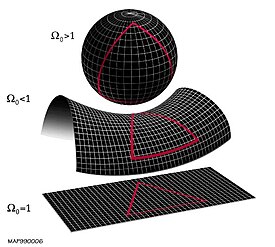Some scientific points
Magnetic Monopole—————————————
The magnetic monopole objection was raised in the late 1970s. Grand unified theories predicted topological defects in space that would manifest as magnetic monopoles. These objects would be produced efficiently in the hot early universe, resulting in a density much higher than is consistent with observations, given that no monopoles have been found. This problem is also resolved by cosmic inflation, which removes all point defects from the observable universe, in the same way that it drives the geometry to flatness.[116]
Flatness problem
The overall geometry of the universe is determined by whether the Omega cosmological parameter is less than, equal to or greater than 1. Shown from top to bottom are a closed universe with positive curvature, a hyperbolic universe with negative curvature and a flat universe with zero curvature.
The flatness problem (also known as the oldness problem) is an observational problem associated with a Friedmann–Lemaître–Robertson–Walker metric (FLRW).[116] The universe may have positive, negative, or zero spatial curvature depending on its total energy density. Curvature is negative, if its density is less than the critical density; positive, if greater; and zero at the critical density, in which case space is said to be flat.
The problem is that any small departure from the critical density grows with time, and yet the universe today remains very close to flat.[notes 4] Given that a natural timescale for departure from flatness might be the Planck time, 10−43seconds,[5] the fact that the universe has reached neither a heat death nor a Big Crunch after billions of years requires an explanation. For instance, even at the relatively late age of a few minutes (the time of nucleosynthesis), the density of the universe must have been within one part in 1014 of its critical value, or it would not exist as it does today.[119]





Comments
Post a Comment